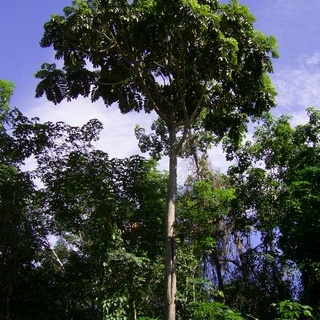Tree up to 45 m tall, evergreen. Leafy twigs 10-20(-40) mm thick, ± densely brown (to whitish) appressedly puberulous to hispidulous, scabridulous or smooth, drying brown; lenticels scattered. Leaves spirally arranged; lamina coriaceous, 30-100(-150) cm long, pinnately incised down to the midrib, with 5-12 segments on each side, these alternate or subopposite, mostly 1-6(-8) cm long petiolulate, subovate to ovate to elliptic, (3.5-)10-20(-40) by (2-)4-8(-13) cm, apex acuminate, base subcordate to subcuneate, usually ± decurrent, margin subentire (or pinnately lobed to parted); upper surface glabrous; lower surface sparsely brownish strigillose on the midrib; lateral veins 7-20 pairs, ‘tertiary’ venation scalariform slightly prominent; ‘rachis’ sparsely brownish strigillose, terminal segment often 3-lobate; petiole 4-9(-16) cm long, (2.5-)5-12 mm thick, sparsely brownish strigose, the lower part ± thickened, the epidermis persistent; stipules fully amplexicaul, (2-)4-10(-17) cm long, brown substrigose to subhirsute, caducous. Staminate inflorescences axillary, usually solitary; peduncle 3-6.5 cm long, brownish (to whitish) appressedly puberulous; head ellipsoid to narrowly ellipsoid to cylindrical, 3-7.5 by 1.5-2 cm; perianth tubular c. 1.8 mm long, the apex 2-lobed, minutely puberulous to subglabrous; stamen 2-2.5 mm long, anther c. 0.2 mm long; interfloral bracts peltate, the apical part 0.6-0.8 mm diam., radially appressedly puberulous. Pistillate inflorescences axillary, usually solitary; peduncle 5-11 cm long, brownish (to whitish) appressedly puberulous; head ellipsoid to subglobose; perianth tubular, the apex convex to flat, minutely brown puberulous to muriculate, aperture surrounded by a rim; stigma simple; interfloral bracts peltate, caducous, the apical part 0.6-0.8 mm diam., radially appressedly puberulous. Infructescences subglobose, 7-8(-10) cm diam., covered with 6-8 mm long, cylindrical apices of the perianths; fruits ellipsoid, 1-1.5 cm long.
More
A medium to large tree. It grows to 24-45 m tall. The trunk can be 60 cm across. There can be buttresses 2.5 m high and 0.5 m wide. The bark is grey. The twigs are 10-20 mm thick. They have brown hairs and ring like scars. The leaves are large and deeply lobed. There are 5-12 alternate pairs of leaflets with a large then a small one. The leaflets are thickly leathery. The flowers occur on leafy twigs. Male and female flower heads are usually in pairs in the same leaf axil. The male heads are finger like and 3-7.5 cm long by 2 cm wide. The stalk is 50-60 mm long. The fruit are round and brown-yellow. They are 11-12.5 cm long by 8-10 cm wide. They are covered with closely set spines. The flesh is orange red in colour. It is sweet and edible. The seeds are oval and 17 mm long by 10 mm wide. They are covered with a thick orange coat. The fruit pulp and seeds are edible.


